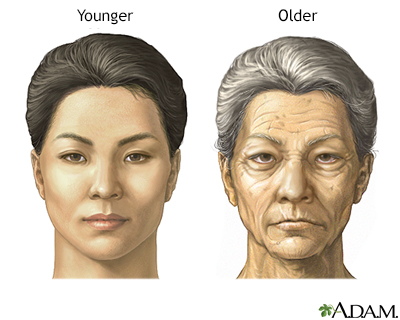Wrinkles
Rhytid
Wrinkles are creases in the skin. The medical term for wrinkles is rhytids.

The skin is the largest organ of the body. The skin and its derivatives (hair, nails, sweat and oil glands) make up the integumentary system. One of the main functions of the skin is protection. It protects the body from external factors such as bacteria, chemicals, and temperature. The skin contains secretions that can kill bacteria and the pigment melanin provides a chemical pigment defense against ultraviolet light that can damage skin cells. Another important function of the skin is body temperature regulation. When the skin is exposed to a cold temperature, the blood vessels in the dermis constrict. This allows the blood which is warm, to bypass the skin. The skin then becomes the temperature of the cold it is exposed to. Body heat is conserved since the blood vessels are not diverting heat to the skin anymore. Among its many functions the skin is an incredible organ always protecting the body from external agents.

With aging, the outer skin layer (epidermis) thins even though the number of cell layers remains unchanged. The number of pigment-containing cells (melanocytes) decreases, but the remaining melanocytes increase in size. Aging skin thus appears thinner, more translucent. Age spots or liver spots may appear in sun-exposed areas. Changes in the connective tissue reduce the skin's strength and elasticity. This is known as elastosis and is especially pronounced in sun-exposed areas.
Considerations
Most wrinkles come from aging changes in skin. Aging of the skin, hair and nails is a natural process.
Frequent or prolonged exposure to sunlight results in early skin wrinkles and dark areas (liver spots). It also increases the chances of getting skin cancer. Exposure to cigarette smoke can also make the skin wrinkle sooner.
Causes
Common causes of wrinkles include:
- Genetic factors (family history)
- Normal aging changes in the skin
- Smoking
- Sun exposure
Home Care
Stay out of the sun as much as possible to limit skin wrinkles. Wear hats and clothing that protect your skin and use sunscreen daily. Avoid smoking and secondhand smoke.
When to Contact a Medical Professional
Wrinkles are not usually a cause for concern unless they occur at an early age. Talk to your health care provider if you think that your skin is getting wrinkled faster than normal for someone your age or if you would like to consider cosmetic treatments for normal wrinkles from aging. A skin specialist (dermatologist) or a plastic surgeon can discuss non-surgical or surgical treatment options with you.
What to Expect at Your Office Visit
Your provider will ask questions, such as:
- When did you first notice that your skin seemed more wrinkled than normal?
- Has it changed in any way?
- Has a skin spot become painful or does it bleed?
- What other symptoms are you having?
Your provider will examine your skin. You may need a skin lesion biopsy if you have any abnormal growths or skin changes.
These are some treatments for wrinkles:
- Tretinoin (Retin-A) or creams containing alpha-hydroxy acids (such as glycolic acid).
- Chemical peels, laser resurfacing, or dermabrasion work well for early wrinkles.
- Botulinum toxin (Botox) may be used to correct some of the wrinkles that are caused by overactive facial muscles.
- Medicines injected under the skin can fill in wrinkles or stimulate collagen production.
- Plastic surgery for age-related wrinkles (for example, a facelift).
References
Draelos ZD. Nonsurgical skin care and rejuvenation. In: Rubin JP, Matarasso A, eds. Plastic Surgery, Volume 2: Aesthetic Surgery. 5th ed. Philadelphia, PA: Elsevier; 2024:chap 7.
Patterson JW. Disorders of elastic tissue. In: Patterson JW, ed. Weedon's Skin Pathology. 6th ed. Philadelphia, PA: Elsevier Limited; 2025:chap 13.
Version Info
Last reviewed on: 10/14/2024
Reviewed by: Ramin Fathi, MD, FAAD, Director, Phoenix Surgical Dermatology Group, Phoenix, AZ. Also reviewed by David C. Dugdale, MD, Medical Director, Brenda Conaway, Editorial Director, and the A.D.A.M. Editorial team.
